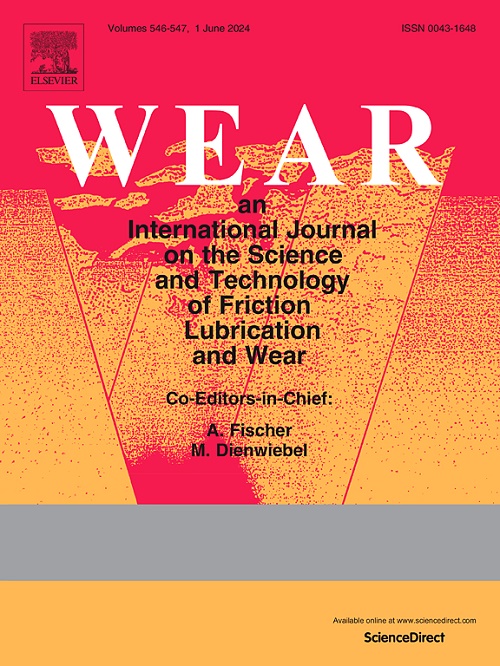A comprehensive investigation of the tribological behaviour of α, α+β, and β titanium alloys against a steel counterpart
IF 5.3
1区 工程技术
Q1 ENGINEERING, MECHANICAL
引用次数: 0
Abstract
The tribological behaviour of three different natures of titanium alloys, the α (T50), α+β (Ti-6Al-4V) and β (Ti-5553), against a steel ball counterpart was investigated for different surface conditions produced by surface severe plastic deformation (SSPD) at room and cryogenic temperatures.
Friction led to the formation of various oxides that acted as third bodies and resulted in different wear regimes referred to as stages I, II, and III. Stage I, the initial abrasive regime under which TiO2-anatase formed, was the only characteristic of the β Ti-5553 alloy behaviour. In addition, stages II and III were observed for the α T50 and α+β Ti-6Al-4V alloys. Stage II is characterised by an increase in the coefficient of friction (COF) associated with the formation of hard TiO2-rutile. Stage III corresponds to the formation of Fe-oxides induced by the steel ball abrasion. While the COF remained steady during stage III for T50, the presence of β-phase in the Ti-6Al-4V destabilised periodically the Fe-oxide layer during stage III and generated repeated sharp drops in the COF values.
Despite increasing hardness and roughness of the treated surfaces, SSPD did not modify the overall mechanisms of abrasion and improved only slightly the tribological properties.

α、α+β 和 β 钛合金与钢的摩擦学行为综合研究
研究了三种不同性质的钛合金--α(T50)、α+β(Ti-6Al-4V)和β(Ti-5553)--在室温和低温下通过表面剧烈塑性变形(SSPD)产生的不同表面条件下与钢球的摩擦学行为。阶段 I 是形成 TiO2-anatase 的初始磨损状态,是 β Ti-5553 合金行为的唯一特征。此外,在 α T50 和 α+β Ti-6Al-4V 合金中还观察到第二和第三阶段。第二阶段的特点是摩擦系数(COF)的增加与硬质 TiO2-Rutile 的形成有关。第三阶段与钢球磨损引起的铁氧化物的形成相对应。虽然 T50 的 COF 在第三阶段保持稳定,但 Ti-6Al-4V 中存在的 β 相在第三阶段周期性地破坏了氧化铁层的稳定性,并导致 COF 值反复急剧下降。
本文章由计算机程序翻译,如有差异,请以英文原文为准。
求助全文
约1分钟内获得全文
求助全文
来源期刊

Wear
工程技术-材料科学:综合
CiteScore
8.80
自引率
8.00%
发文量
280
审稿时长
47 days
期刊介绍:
Wear journal is dedicated to the advancement of basic and applied knowledge concerning the nature of wear of materials. Broadly, topics of interest range from development of fundamental understanding of the mechanisms of wear to innovative solutions to practical engineering problems. Authors of experimental studies are expected to comment on the repeatability of the data, and whenever possible, conduct multiple measurements under similar testing conditions. Further, Wear embraces the highest standards of professional ethics, and the detection of matching content, either in written or graphical form, from other publications by the current authors or by others, may result in rejection.
 求助内容:
求助内容: 应助结果提醒方式:
应助结果提醒方式:


